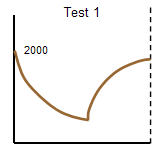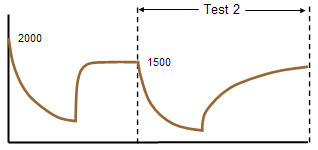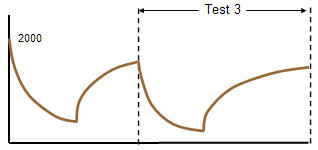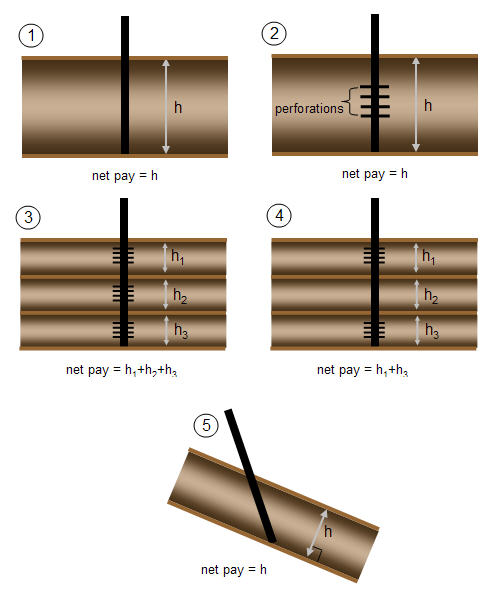This topic describes the key terminology for reservoir properties.
Drainage area
This is the areal extent of the reservoir. It is most often determined from geological information about the formation / region, but it can also be estimated from performance studies such as material balance, interference analysis, and simulation studies.
Expected ultimate recovery
The expected ultimate recovery (EUR) is the amount of oil or gas that can be economically recovered from a reservoir under current operating and economic conditions.
Formation compressibility
Formation compressibility is the change in pore volume per unit of pore volume per unit change in pressure. Even though the formation is a solid material, it is compressible. The formation compressibility is used in the calculation of total compressibility. It is of the same order of magnitude as the oil compressibility, or the water compressibility, approximately 10-6 psi-1.
Thus, in the absence of gas saturation, the formation compressibility is relatively significant and must not be ignored. However, when there is gas present in the pores, the gas compressibility is often one or two orders of magnitude higher, and so the formation compressibility is relatively small and may be ignored.
The formation compressibility may be measured in the laboratory, but it is usually derived from correlations. It is obvious that the nature of the formation, its degree of consolidation, its stress field, etc. all affect the formation compressibility, yet the correlations that exist do not take all of these factors into account. They are very simplified and relate the formation compressibility to the total porosity. The correlation used in Harmony Enterprise is derived from laboratory measurements [Hall, 1953], and is applicable to sandstones and carbonates. For overpressured reservoirs, the formation compressibility can be 10 times larger than suggested by the Hall correlation. In practice, it has been found that formation compressibility for overpressured reservoirs is approximately equal to 10-5 psi-1.
Gas saturation
Gas saturation is the fraction of the pore space occupied by gas. Most gas reservoirs also contain some connate (non-movable) water. If the gas reservoir is part of a gas cap in a saturated oil reservoir, the space may contain gas, oil, and water. Thus, the gas saturation is rarely 100% but varies from 30% to 90%.
Gas saturation is used directly in the calculation of the reserves, and also in the calculation of total compressibility.
Note that the gas saturation has a significant effect on the total compressibility because the gas compressibility is much higher than the fluid compressibility of oil and water.
Initial pressure
Reservoir pressure is the pressure of fluids within the pores of a reservoir measured at a specific point in time. The initial reservoir pressure is the average reservoir pressure measured in a discovery well before any fluid is produced. This value is necessary for many reservoir engineering calculations, such as reserve determination. Units are typically psi (field units) or kilopascals (SI).
For well testing, the initial pressure is the average reservoir pressure before the start of a test. For a new well, a well that has not been put on production, the initial pressure equals the virgin or original pressure and corresponds to a drillstem test pressure. For a well that has been on production for a long time, the initial pressure may or may not be equal to the original reservoir pressure. The following example illustrates this concept.



- If Test 1 is being analyzed, the initial pressure is 2000.
- If Test 2 is being analyzed, the initial pressure is 1500 because the reservoir pressure is fully built up before this test, and the historical pressure prior to Test 2 does not apply. Thus, it behaves like a new well with an initial pressure 1500.
- If Test 3 (which is a combination of Test 2 and some production prior to Test 2) is being analyzed, the initial pressure is 2000, because it must reflect the reservoir pressure before the production that is being analyzed during the test.
Mid-point of perforations
Perforations are the communication tunnel created from the casing or liner into the reservoir formation through which the oil or gas is produced. The mid-point of perforations is the measured depth from the surface to the mid-point of the perforated interval of the formation.
Net pay
Net pay is the thickness of the formation that contributes to the flow of fluids, or the sum of the productive intervals of a reservoir. It is determined from core or log analysis, and can be different from the gross pay or the perforated interval. In the case of an inclined or deviated wellbore in a declining formation, the net pay is measured perpendicular to the angle of decline. Several examples of net pay are shown below.

Oil saturation
Oil saturation is the fraction of the pore space occupied by oil. Most oil reservoirs also contain some connate (non-movable) water. Thus, the oil saturation is rarely 100% and usually ranges from 10% to 90% (in the oil / water transition zones). The oil saturation affects the oil and gas reserves, and is also used in the calculation of total compressibility.
Original fluid-in-place
Original fluid-in-place (OFIP) is the amount of fluid contained in a reservoir at standard conditions, as calculated from the reservoir and fluid properties. It is a general term that refers to the calculation of original gas-in-place (OGIP) and/or original oil-in-place (OOIP).
Porosity
The total porosity is the percentage volume occupied by the pore space, regardless of the type of fluids contained in the pore space. It is obtained from core or log analysis. Total porosity is used to calculate volumetric reserves and formation compressibility, and is used in the pressure transient flow equations.
The total porosity has only a small effect during the transient flow period (it occurs within the log term in the skin calculation equation for radial flow), but it has a significant effect during pseudo-steady state (PSS) flow, as it directly affects the reserves contained in the reservoir.
Rock volume
The total volume of reservoir rock, often referred to as the bulk volume.
Pore volume
The total volume of pore space within the reservoir as determined by the porosity of the rock.
Hydrocarbon pore volume
The total pore volume containing hydrocarbons. This is generally the product of pore volume and water saturation.
Recovery factor
The recovery factor (RF) is the ratio of the expected ultimate recovery and original gas/oil-in-place. It indicates how much of the original gas/oil-in-place can be recovered under current operating and economic conditions.
Reservoir temperature
The reservoir temperature represents the temperature of the formation. It increases with reservoir depth and differs widely depending on the reservoir location's geothermal gradient. The geothermal gradient is the rate of increase in temperature per unit depth in the earth. Although the gradient is variable depending on location, a typical average value is 15°F / 1000 ft.
In the analysis of gas wells, the reservoir temperature is used directly in the pressure transient analysis calculations, as well as calculating all the gas fluid properties, such as the gas formation volume factor, gas viscosity, and gas compressibility.
In the analysis of oil wells, the reservoir temperature does not enter into the pressure transient analysis equations directly; rather it is used in calculating oil fluid properties such as the oil formation volume factor, oil viscosity, oil compressibility, and solution gas-oil ratio.
Units are typically Rankine (field units) or Kelvin (SI).
Total compressibility
The compressibility of a substance is the change in volume per unit volume per unit change in pressure. In a reservoir that consists of rock and pore space occupied by oil, water, and gas, the total compressibility is defined as follows:
From this definition, the total compressibility takes into account the compressibility and saturation of gas, oil, and water, as well as the (rock) formation compressibility. Note that the gas saturation has a significant effect on the total compressibility because the gas compressibility is much higher than the other fluid compressibility (oil and water). Thus, if there is any gas present in the reservoir, the total compressibility is dominated by the gas compressibility component.
In well testing and rate transient analysis, the analysis of pressure and production data is based on the solution of the diffusivity equation. The analytical solution of this equation assumes that the total compressibility is constant. This assumption is valid for single-phase liquid systems. In gas systems, because compressibility of gas is highly dependent on pressure, the assumption of a constant value of total compressibility can lead to serious errors, especially when the reservoir has started to deplete (that is, during boundary-dominated flow). To account for this changing gas compressibility, the concept of pseudo-time is invoked. It accounts for the variation with pressure of compressibility, viscosity, and permeability.
The units of compressibility are 10-6 psi-1. (1 * 10-6 psi-1 (sometimes referred to as 1 Microsip.)
- co ≈ cw ≈ cf ≈ 10-6 psi-1
- cg ≈ 10-3 psi-1 @ 500 psi
- cg ≈ 10-3 psi-1 @ 1000 psi
- cg ≈ 10-4 psi-1 @ 2500 psi
- cg ≈ 10-4 psi-1 @ 5000 psi
- cg ≈ 10-5 psi-1 @ 10,000 psi
- cg ≈ 10-5 psi-1 @ 15,000 psi
Water saturation
Water saturation is the fraction of the pore space occupied by water. Most reservoirs are water wet and contain connate water. Water saturation may range from 10% to 50% for an oil or gas reservoir, and it is 100% for an aquifer. The water saturation obviously affects oil and gas reserves, and it is also used in the calculation of total compressibility.
Wellbore radius
The wellbore radius is half of the measured inside diameter of the borehole at the point of perforation. This is not to be confused with the effective wellbore radius, which accounts for changing skin during production or after stimulation. The wellbore radius and effective wellbore radius are equivalent when the skin is equal to zero.